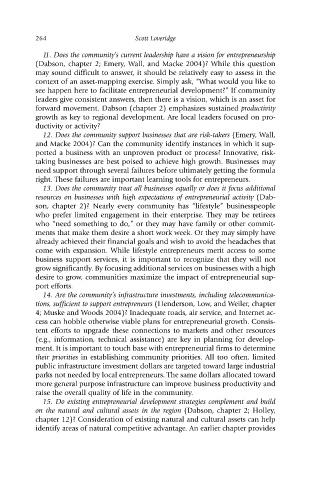Page 275 - 1-Entrepreneurship and Local Economic Development by Norman Walzer (z-lib.org)
P. 275
264 Scott Loveridge
11. Does the community’s current leadership have a vision for entrepreneurship
(Dabson, chapter 2; Emery, Wall, and Macke 2004)? While this question
may sound difficult to answer, it should be relatively easy to assess in the
context of an asset-mapping exercise. Simply ask, “What would you like to
see happen here to facilitate entrepreneurial development?” If community
leaders give consistent answers, then there is a vision, which is an asset for
forward movement. Dabson (chapter 2) emphasizes sustained productivity
growth as key to regional development. Are local leaders focused on pro-
ductivity or activity?
12. Does the community support businesses that are risk-takers (Emery, Wall,
and Macke 2004)? Can the community identify instances in which it sup-
ported a business with an unproven product or process? Innovative, risk-
taking businesses are best poised to achieve high growth. Businesses may
need support through several failures before ultimately getting the formula
right. These failures are important learning tools for entrepreneurs.
13. Does the community treat all businesses equally or does it focus additional
resources on businesses with high expectations of entrepreneurial activity (Dab-
son, chapter 2)? Nearly every community has “lifestyle” businesspeople
who prefer limited engagement in their enterprise. They may be retirees
who “need something to do,” or they may have family or other commit-
ments that make them desire a short work week. Or they may simply have
already achieved their financial goals and wish to avoid the headaches that
come with expansion. While lifestyle entrepreneurs merit access to some
business support services, it is important to recognize that they will not
grow significantly. By focusing additional services on businesses with a high
desire to grow, communities maximize the impact of entrepreneurial sup-
port efforts.
14. Are the community’s infrastructure investments, including telecommunica-
tions, sufficient to support entrepreneurs (Henderson, Low, and Weiler, chapter
4; Muske and Woods 2004)? Inadequate roads, air service, and Internet ac-
cess can hobble otherwise viable plans for entrepreneurial growth. Consis-
tent efforts to upgrade these connections to markets and other resources
(e.g., information, technical assistance) are key in planning for develop-
ment. It is important to touch base with entrepreneurial firms to determine
their priorities in establishing community priorities. All too often, limited
public infrastructure investment dollars are targeted toward large industrial
parks not needed by local entrepreneurs. The same dollars allocated toward
more general purpose infrastructure can improve business productivity and
raise the overall quality of life in the community.
15. Do existing entrepreneurial development strategies complement and build
on the natural and cultural assets in the region (Dabson, chapter 2; Holley,
chapter 12)? Consideration of existing natural and cultural assets can help
identify areas of natural competitive advantage. An earlier chapter provides

